Blind Cave Fish and the Science of Island Biogeography
This post is Part 2 of a series on speleology. Part 1.
Ever wondered why Darwin's greatest insights came from the Galapagos Islands? It's the same reason why evolutionary biologists today swarm there. It's also the reason they swarm to patches of forest freshly separated by lava flows in Hawaii. It's also the same reason they swarm to cave ecosystems.
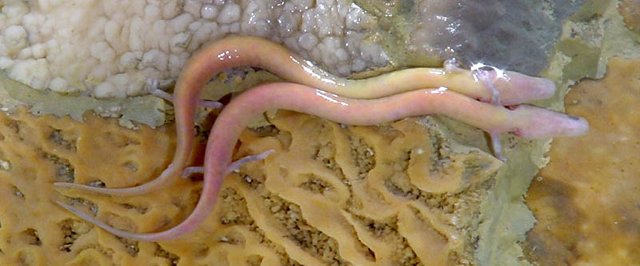
A pair of olms, a type of blind, cave-dwelling salamander. Along with drastically enhanced smell and hearing, they also have electrorecptors, lateral lines, and more senses. They also retain gills and other larval traits into adulthood. Picture taken in Slovenia. [Image source]
Isolated ecosystems like islands, disaster-split forests, mountaintops, or caves are hotbeds for evolution. Essentially, the 'islands' that island biogeography discusses are merely any ecosystem surrounded by entirely different ecosystems. Evolution there proceeds at a breakneck pace when compared to geographically larger and more contiguous ecosystems. It's the reason you tend to get such extreme adaptations in these environments. Gigantism, dwarfism, extreme specialization, etc. In caves, you get blindness, albinism, enhanced hearing and smell along with other senses, extremely slow metabolisms, and more. Creatures with these adaptations are known as troglomorphs.
Each of these cave adaptations, makes considerable sense, though many of them seem foolish or even harmful. Take blindness, for instance. While evolving to lose your sight would be a death sentence for a creature elsewhere, eyes in a place without light just waste energy. Albinism leaves you vulnerable to harmful rays from the sun- but there isn't any sun in caves. Wasting energy growing pigments to protect yourself from the sun is just going to hurt your chances. Enhanced hearing and smell's utility in a cave make obvious sense.
These cave fish, Phreatichthys andruzzii, are not only blind, but lack eyes entirely. They have a 47 hour cycle, rather than a 24 hour one, given their complete nonresponsiveness to light. [Image source]
The slow metabolism, though? That one seems weird, but it's actually the most powerful adaptation of all for cave dwellers. Caves are incredibly, incredibly low energy environments. The low metabolism allows creatures to go for weeks or months between meals perfectly fine. They also often tend to have much longer lifespans. Greenland sharks also have these adaptations. These adaptations wouldn't work in richer ecosystems, however- there the biological advantage goes to fast moving organisms with fast-burning metabolisms. When there's more to gain, you need to live faster.
With the exception of black smokers in the ocean, the sun is the source of energy for just about every ecosystem. Caves are incredibly nutrient poor. In some of them you have bats flying out and returning, with their poop fueling the ecosystem. In others you might have a river running into it bringing in nutrients. Often, however, these caves are incredibly toxic, filled with sulfur dioxide and other toxic gasses, and cut off from the outside world, and yet you still find ecosystems in these places. They survive off of nutrients carried in groundwater percolating into the caves, and have often been sealed off for countless millennia.
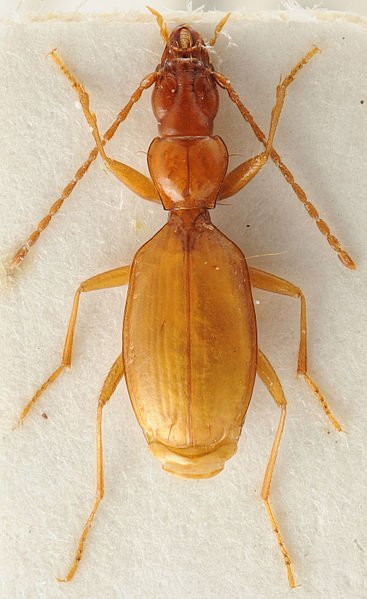
Anopthalamus hitleri, a blind beetle only found in five caves in Slovenia. It was named after the genocidal German dictator before WWII, and despite frequent efforts to change it, it's against taxonomic traditions to change latin names. I still think they should change this one, though. [Image source]
So why does evolution proceed so quickly in caves and other biological 'islands'? There's a few reasons for it. First off, the higher populations in larger ecosystems are more resistant to adaptation- there, it's less likely that all members of a population lacking an adaptation will die off, leaving only that adaptation. This significantly slows the process. Next, these islands tend to be more dangerous, resource poor places. There's simply more potential reward for risky strategies, and less reward for conservative ones.
Of course, there's a flip side to all of this. While evolution often proceeds much more quickly on islands, so do extinctions and ecosystem collapses. Biological islands often lack the complex food chains and stable ecosystems found in larger regions. So the discipline of island biogeography also studies a couple more ideas, as well. First off, they try and determine what the minimum size and complexity of an ecosystem can be before it collapses. The application of this should be pretty easy to understand today, with all of the manmade ecological damage, extinctions, and creation of biological islands cut off by roads, logging, cities, dams, and other human works.
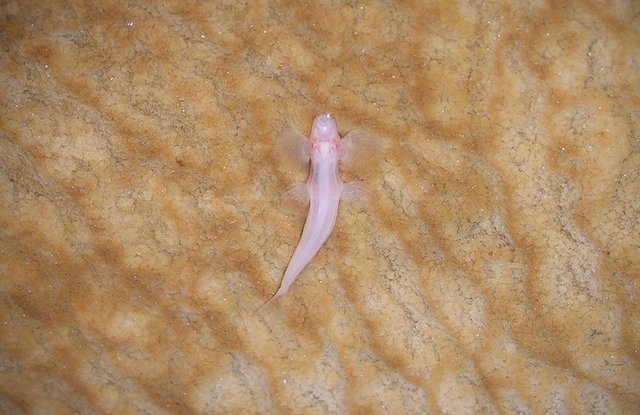
The waterfall-climbing cave fish, Cryptotora thamicola. As its name suggests, it's capable of walking with or even climbing with its powerful fins for its small size. It has no visible eyes or skin pigment. The fish lives in areas of a network of Thailand caves with fast moving water, and filters out biological sediments from them. [Image source]
In addition, they study how long it takes for a collapsed ecosystem to be resettled by life. Biologists are always flocking to the sites of volcanic eruptions and forest fires- there are still multiple teams working in the blast radius of Mount Saint Helens, for instance. (I once interviewed for an internship with one of them, and was one of the final two applicants- but my lack of a car did me in.) There are pretty direct applications here as well- biologists have been pushing more and more for the construction of greenways, artifically constructed "nature roads" linking one isolated ecosystem to another. Bridges covered in trees and grass going over freeways, for example.
Despite the extreme conditions of caves- their isolation, nutrient poverty, darkness, and frequent toxicity- they make excellent study areas for understanding the ecosystems we live in. The very sparseness of insular ecosystems is what makes them so useful to study for us, as it did for Darwin. If we are to preserve the ecosystems we live in, we need to understand how much damage they can take and how we can prevent and mitigate that damage.
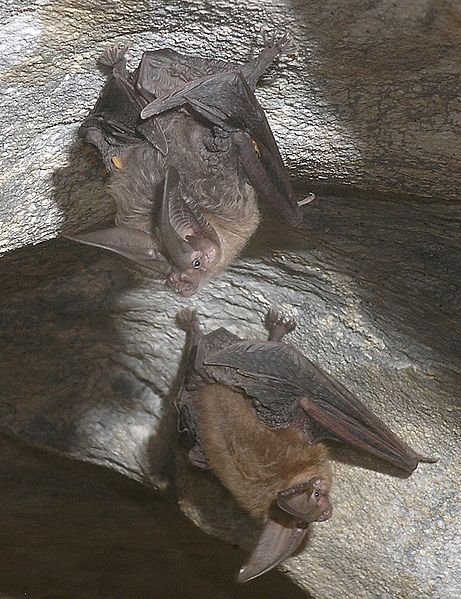
Townsend's Big-Eared bats in a cave in California. [Image source]
****************************************
Bibliography:
The Song of the Dodo, by David Quammen
https://en.wikipedia.org/wiki/Cavefish
https://en.wikipedia.org/wiki/Insular_biogeography
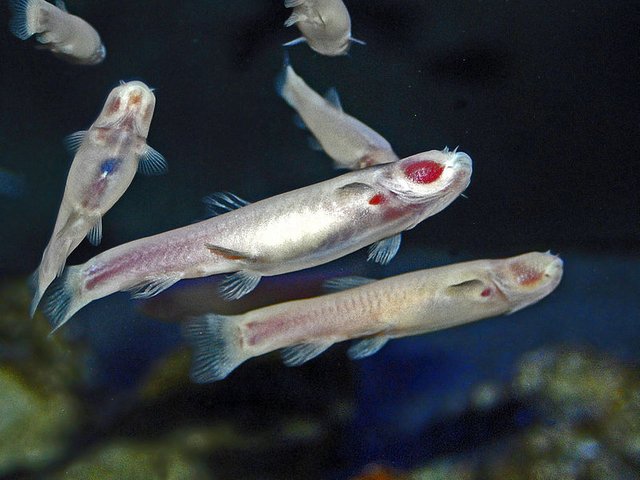
As I'm reading, I'm wondering whether this can be extrapolated to economic systems. Capitalism is supposed to favor innovation via open and large-scale competition, but here you're telling us restricted and small-scale may often be better and faster. I was always an advocate of trying out every economic (and maybe political and why-the-hell-not let's throw in sexual) idea in isolated regions, and see how they do.
Thoughts?
It's not that smaller is better, it's that smaller is less resistant to change than larger, allowing for extremely rapid change. That change is often failure or extinction, but it's also often also highly successful local adaptations.
It the economic realm, note that communism's most persistant bastion, Cuba, is an island both in the physical and economic senses.
Politically and economically, large scale systems are more resilient, as holds true for most complex systems. They do tend to ignore local knowledge/metis, however, the social equivalent to those highly specialized island adaptations. (For more on metis and large-scale systems, I highly recommend James C. Scott's Seeing Like A State.)
It should also be reiterated that many of those island adaptations, while extremely effective, often come at high metabolic cost or high competitive cost, and the same is true of political systems- which is simultaneously an argument for and against your suggestion.
This post has my seal of approval
It really is the best seal of approval. And most adorable.
It’s so adorable I want one!! 😭🙌🏽
What an amazingly wonderful post. I love the detail, writing and my favorite were the bats! The cave dwellers reminded me of that movie where the girls go into a cave and only one Makes it out because the people that lived in the caves for so long lost eyesight and became nocturnal. Thank you for all the work that went into this and sharing! 🙏🏽
Thanks for reading!
Truly interesting and I enjoy your writing. Learning about different species in the world is great. Thank you again!
Yep, I love pointing these creatures out to those who deny evolution.
It's definitely a challenge for them!
enjoyed your post
Glad to hear it!
@originalworks
The @OriginalWorks bot has determined this post by @mountainwashere to be original material and upvoted it!
To call @OriginalWorks, simply reply to any post with @originalworks or !originalworks in your message!
Your Post Has Been Featured on @Resteemable!
Feature any Steemit post using resteemit.com!
How It Works:
1. Take Any Steemit URL
2. Erase
https://3. Type
reGet Featured Instantly – Featured Posts are voted every 2.4hrs
Join the Curation Team Here
This post has received a 0.24 % upvote from @drotto thanks to: @banjo.